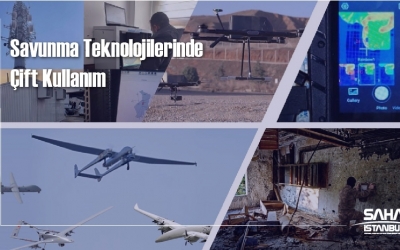
Korean War and Aftermath
The Korean War, which began on June 25, 1950, with the invasion of South Korea by North Korea supported by China and the Soviet Union, escalated and spread to an international arena. The war resulted in the signing of the Panmunjom Armistice Agreement in 1953, and South Korea, which had become one of the poorest countries in the world, initiated a large-scale reconstruction process. During the presidency of Park Chung-Hee, who came to power through a military coup in 1961, a program focused on industrialization and economic development was implemented. It was recognized that the development of new technologies was necessary to increase the country's competitiveness, and an incentive system was established, which was successfully implemented. In 1969, with the announcement of the Guam Doctrine by US President Richard Nixon, it was anticipated that the United States would gradually withdraw from Asia. The need for South Korea to establish a self-sufficient national defence industry became prominent due to the withdrawal of the US 7th Infantry Division of approximately 20,000 personnel from Korea in 1971. In the 3rd Five-Year Economic Development Plan (1972-1976) prepared by the Defence Sciences Research Institute, heavy industrialization similar to Kardemir and MKE in Turkey was targeted, and a defence industry development plan was prepared. The programs aimed to reduce South Korea's dependence on defence imports and aimed to domestically produce and nationalize basic weapon systems. Machine guns, anti-tank rockets, artillery guns, and other weapon systems were started to be produced domestically through technology transfer from the United States. As a result of ongoing programs, aircraft and howitzer technologies were transferred, and the construction of destroyers, domestic tanks and armoured vehicle production was realized.
Recent Developments
In the late 1990s, South Korea, adapting to the US Military Affairs Revolution concept, took giant steps to strengthen its national defence capabilities by developing military technology and capabilities. On the other hand, in 1991, economic cooperation credits were granted to the Soviet Union, and with the dissolution of the Soviet Union, Russia paid off its debts by providing the latest weapon technology to South Korea. This situation became an important opportunity for the development of South Korea's defence industry. In 1990, the government announced a 40 billion dollar program for a five-year period (1990-1994) to establish research units in companies and universities for advanced materials, microelectronics, bioengineering, fine chemicals, optics, and aircraft development. The goal of the program was to increase production in these areas from 14 billion dollars in 1987 to 50 billion dollars in 1994 and to 140 billion dollars by the year 2000. In 2008, the government identified the promotion of the defence industry as a national priority. The aim was to achieve continuous economic growth by promoting the defence industry. Additionally, in order to prevent monopolization in the defence industry, a regulation called the "multiple supplier system" was introduced.
Current Developments
South Korea's defence exports have reached a significant level in recent years, and according to SIPRI data, annual defence exports have reached up to 15 billion dollars, making South Korea the eighth largest defence exporter in the world. The interest of Eastern European countries in the K9 howitzer and K2 tank produced in South Korea played a major role in this success. Russia's invasion of Ukraine encouraged a global effort to increase the production of missiles, tanks, artillery shells, and other ammunition. During this period, very few countries were able to increase their production as rapidly as South Korea. In April 2023, South Korea reached a 12.4 billion dollar agreement to supply approximately 1,000 K2 tanks, more than 600 artillery systems, and a range of fighter aircraft to Poland. This agreement became South Korea's largest arms deal to date. Furthermore, after Turkey, which was the Leading Country in last year's MSPO fair, this year South Korea will participate as the leading country.
There are 80 major companies operating in South Korea's defence industry, employing approximately 45,000 people. Of these 80 companies, 44 have more than 500 employees.
Conclusion
The developments in South Korea's defence industry and exports since the 1970s have supported the country's military modernization and brought about significant changes in the defence industry. During this process, while South Korea developed its domestic capabilities to meet its defence needs, it also became an exporter of defence industry products. Export activities, particularly in products such as weapon systems, submarines, warships, missiles, and other military equipment, have increased. South Korea aims to be among the world's top four defence exporters by 2027. South Korea's defence industry model has certain characteristics that should be taken as an example by many countries:
- Encourages economic development: South Korea's defence industry model aims to promote the country's economic growth and industrialization. The defence industry involves the production of high-tech and high-value-added products. This allows the country to develop its capabilities in science and technology and can trigger a broader economic development process.
- Encourages technology transfer and domestic production: South Korea's defence industry model aims to develop domestic defence industry capabilities. The domestic production and nationalization of basic weapon systems strengthen technology transfer and the domestic defence industry infrastructure. This enables the country to meet its defence needs in a more independent manner and reduce dependence on imports.
- Increases defence exports: South Korea has become a significant exporter in the defence industry. Other countries can take South Korea's defence industry model as an example to develop their own defence industries and achieve a competitive position in international defence exports. South Korea's success can be an inspiration for countries with export potential.
- Provides employment: South Korea's defence industry provides employment for many people. The approximately 45,000 employees in the 80 defence industry companies make significant contributions to the country's economy. Other countries may have the potential to create employment through the defence industry.
- Strengthens national defence capability: South Korea has significant defence capabilities in the defence industry. Other countries can strengthen their national defence capabilities by taking South Korea's defence industry model as an example. This increases countries' defence independence and makes them more effective in ensuring their security.
SAHA Blog

Strategic Importance of Africa: Natural Resources, Security, and Geopolitical Dynamics

Overview of Tanks on the Battlefield: Russia-Ukraine War

Enhancing Global Security in Civil Aviation: The Crucial Role of Air Defence Systems

Uzay Savaşının Gelişen Askeri Doktrinler ve Strateji Üzerindeki Etkisi

Biyosavunma: Doğanın Gücünden İlham Alıyor

Güç Gösterisinde Etkili Bir Savunma Stratejisi: A2/AD Doktrini

Savunma Teknolojilerinde Çift Kullanım


